Behaviour
Caring for babies
Bottle feeding
Changing a nappy
Cleaning and sterilising bottles
Daily cleaning tasks
Helping new children settle in
Preparing for a nappy change
Sleep patterns – babies
Sleep routines – babies
Toilet training
Caring for children
Allowing time for practice
Dressing/undressing
Mealtimes
Nappy change
Packing away/caring for the environment
Sleep/rest time
Toileting
Common self-help milestones
Tips for sleep and rest time
Self image
Communication
Body language
Limits and guidelines
Ways children communicate
Greeting children and families
Modelling appropriate communication
Questioning
Verbal and non–verbal communication
Acknowledging children's feelings
Listening attentively
Communicating with Aboriginal and Torres Strait Islander parents/carers
Development
Allowing time for practice
Dressing/undressing
Mealtimes
Nappy change
Packing away/caring for the environment
Sleep/rest time
Toileting
Common self-help milestones
Creative development
Language development
Modelling positive relationships
Physical development
Sharing and taking turns
Sleep patterns – babies
Sleep routines – babies
Encourage independent problem solving
Fundamental movement skills
Health, hygiene and safety
Coping with stress
Correct manual handling principles
Daily cleaning tasks
Hand washing
Hand washing poster
Manual handling overview
Toilet training
Safety checklist
Learning experiences and play
Environmentally friendly learning experiences
Learning experiences for different development areas
Creative resource materials
Arranging the environment to facilitate learning and pleasure
Indoors and outdoor areas
Creating a positive physical environment
Legal and ethical issues
Child abuse case studies
How do I recognise when a child or young person is at risk?
Tips on dealing with disclosures
Observation methods
Arranging Experiences (PDF 351Kb)
Recording observations
Rules for making observations
What you can learn from observations
Programming
Children’s interests, strengths, needs and skills
Extending the children’s interest in dinosaurs
Objective observation
Planning an OSHC environment
Behavior management plan
Planning enjoyable experiences
Planning experiences for 0 - 2 years age group
Planning experiences for 2 - 3 years age group
Planning experiences for 3 - 5 years age group
Hand washing
Hand washing is the most effective way to prevent the spread of infection.
When would you usually wash your hands?
When you're caring for children, it's important to be particularly careful to wash your hands every time you may be at risk of spreading germs or bacteria.
Wash your hands:
- before handling food and drink
- after going to the toilet
- before and after administering first aid
- after using paint or other materials
- after cleaning up body fluids
- before and after nappy changing
- after handling pets
- after blowing your nose
- after coughing into your hand
- after scratching your head or playing with your hair.
Can you think of any other times when you might need to wash your hands?
Read through the hand washing procedure below. It shows the correct way to wash your hands to reduce the spread of infection.
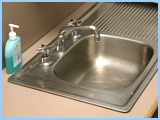 |
Step 1: Go to the basin. |
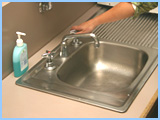 |
Step 2: Turn on the cold water tap. |
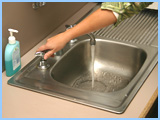 |
Step 3: Turn on the hot tap and adjust the flow of the running water to the desired temperature. |
 |
Step 4: Wet your hands. |
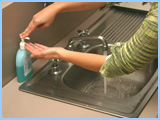 |
Step 5: Apply the soap. |
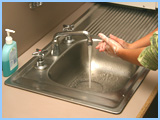 |
Step 6: Rub your hands together briskly, including the backs of your hands, between your fingers (don't forget the thumbs!) and around your nails and wrists. |
 |
Step 7: Rinse your hands under the running water for ten seconds. |
 |
Step 8: Turn off the tap firmly, using a paper towel. Contribute to water savings by ensuring the water flow has completely stopped. |
 |
Step 9: Dry your hands with a paper towel. |
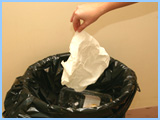 |
Step 10: Dispose of the paper towel without re-contaminating your clean hands. |